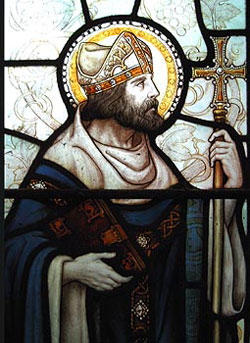Welsh: Dyfrig
Norman-French: Devereux
Latin: Dubricius, Dubricus
Born: 465(?) in Madley, England
Dead: 550 on Bardsey Island, Wales

Saint Dubric is an important figure in early Welsh Christianity. He was a Welsh bishop and is considered one of the founding saints of the Welsh Church.
He is believed to have lived in the fifth and sixth centuries and played a significant role in spreading Christianity in Wales during that time. He was associated with the establishment of numerous monastic communities and the conversion of many people to Christianity.
According to tradition, Saint Dubric was consecrated as the bishop of Llandaff, an ancient city in present-day Cardiff, Wales. He is credited with the foundation of the Diocese of Llandaff and the establishment of its cathedral.
Saint Dubric is associated with the establishment of monastic communities at Hentland and Moccas, villages in Herefordshire. He served as a tutor to both Saint Teilo and Saint Samson. In the Welsh hagiographic accounts, he is credited with being the Bishop of Ergyng (also known as Archenfield).
Saint Dubric is also associated with the Synod of Llanddewi Brefi, where he supposedly resigned his position as Archbishop of Caerleon-on-Usk and transferred authority to Saint David. This event marked an important transition in the ecclesiastical hierarchy of Wales. He then retired to Bardsey Island where he was buried, but later on, in 1120, his remains was taken to Llandaff Cathedral. The Annales Cambriae say that he died in 550 or 612.
In Welsh legend, he is said to be the illegitimate son of the daughter of King Peibio Clafrog, ruler of Ergyng (located in present-day Herefordshire, England), Efrddyl. Her father tried to drown her in the River Wye, but didn’t succeed. Efrddyl gave birth to Dubricius in Madley. His grandfather, Peibio, had leprosy from which he was cured when the boy touched him, and they were reconciled.
Geoffrey of Monmouth places his life nearly a century earlier and connects him with Arthur. According to Geoffrey, King Ambrosius appointed Dubric to the see of Caerleon. Later, Dubric crowned Arthur king of Britain. According to Geoffrey, Dubric was primate of Britain and so eminent in piety that he could cure any sick person by his prayers. He abdicated later to become a hermit.
Dubric proved to be an important spiritual leader during Arthur’s reign, inspiring Britons to fight for their land and to accept Arthur as their true leader. To Tennyson, however, Dubric is the “high saint” who not only crowned Arthur but officated at his marriage, and who is as eminent in the spiritual realm as Merlin in the magical.
The Vulgate Merlin calls Dubric the Archbishop of Brice, misinterpreting the first syllable (“Du”) of his name for the French word meaning “of.”
Malory seems to know nothing of him, unless Saint Dubric is to be identified with the Archbishop of Canterbury.
Sources
Annales Cambriae | c. 960-980
Historia Regum Britanniae | Geoffrey of Monmouth, c. 1138
Roman de Brut | Wace, c. 1155
Idylls of the King | Lord Alfred Tennyson, 1859-1886
